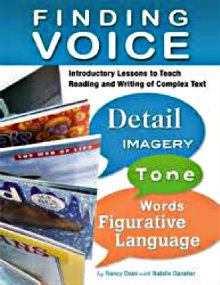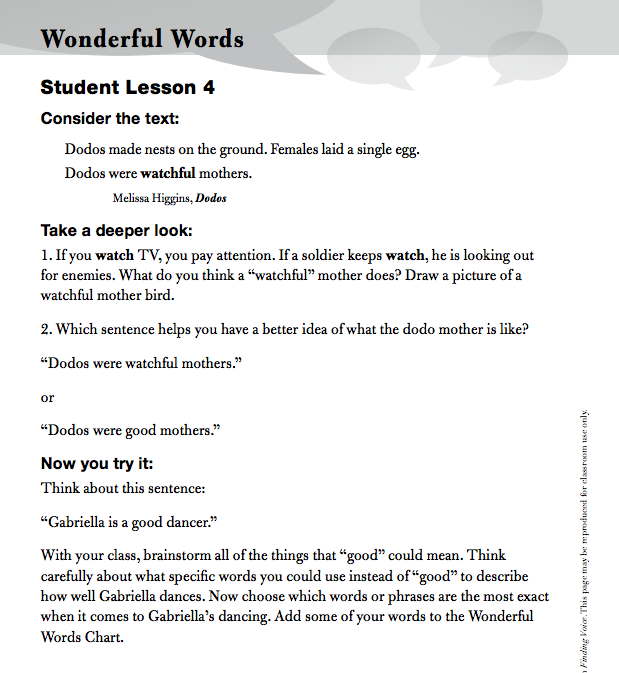Good Intro Lessons for Teaching Complex Texts
Finding Voice: Introductory Lessons to Teach Reading and Writing of Complex Text
By Nancy Dean with Natalie Danaher
(Maupin House/Capstone, 2016 – Learn more)

Every once in a while, an author writes a professional book that is “just what I needed.” Finding Voice: Introductory Lessons to Teach Reading and Writing of Complex Text is a great resource for upper elementary teachers including Grade 6. This special book is about reading closely and learning how to write to express yourself. It’s all about “voice.”
Voice is what makes reading interesting. It’s what makes us say, ‘I’ll bet that book is by J.K. Rowling or Lemony Snicket.’ Voice gives color and texture to writing. It is the expression of personality…voice comes from conscious choices.” (p. ii)

On the other hand, there are pieces that are so bland that you wonder what you could do to help the writer spice up the writing. You may feel that you have tried just about everything in your power and nothing is working. It sounds “blah, blah, blah…” but you don’t want to give up. You want your students to discover how to make their writing go from “ho hum” to “Ta! Da! Drum roll!!!”
Finding Voice: Introductory Lessons to Teach Reading and Writing of Complex Text is a GPS system for the language arts teacher. It is a guide and repository of lessons that will help you navigate the murky pieces of writing that may grace your desk – and make that writing clear and inviting to read.
A useful chapter structure
What is great about this book is the format. First, it is easy to read. The lessons are built on theory and the authors’ experiences. Each lesson starts with “consider the text,” a relatively short passage for students to read and discuss. The next section, “take a deeper look,” provides two questions that you can use to guide the student discussion about the text and the use of voice in the text. Finally, the students get a chance to create their own voice using the passage as mentor text.
I always welcome books that can help my students become better writers. I want them to explore the craft of writing and for writing to become something they look forward to instead of dread. This book, which is meant to supplement your curriculum rather than replace it, focuses on five areas: word choice, detail, imagery, figurative language and tone.
Better mentor text accessibility
The very short mentor texts help keep your mini lesson “mini” and give students ample time to write and try each strategy on their own. However, I do wish the sample texts were also written in an appendix or available to print from an online link, instead of merely being embedded in the lesson plans.
I like my students to have a copy of the text with them as I teach the lesson so they can annotate on their own page while I display the similar text on the whiteboard or on a chart. It would make the teacher’s life a little easier if he or she didn’t have to retype and print the text.
Effective gradual release
On the plus side, each lesson is written using best practices, such as “to, with, and by”(gradual release), which gives the teacher ideas on how to model, then have the students work with each other, and finally have them try it on their own.
I also like the fact that these are not prescriptive lessons. That is, the students are actively involved in trying out each lesson, not just completing worksheets. An example is having them act out taking off a tight pair of shoes they have outgrown, found in the lesson about choosing the perfect word that creates a particular picture. (p.9)
I found the “now you try it ideas” decidedly creative and student friendly. “Pretend it is a bad day in the cafeteria. You have been served something shapeless and tasteless and you are not even sure what it is. Write a sentence describing the food on your tray. Chose words that help the reader vividly experience what you describe. Use sentence four from The Horrible, Miserable Middle Ages as a model.” (p. 17)
I can truly envision this lesson and the student who may have been a reluctant writer excited about writing and sharing his writing.
Widely adaptable
I strongly feel that as you adapt these lessons to fit your students’ needs, you will see consistent and evident progress. The lessons (approximately a dozen) for each element of voice graduate in difficulty and complexity. You can use them with a whole class, in small groups, or as a guided reading activity.
It is important to note that the teacher is always part of the equation. It is up to you to adapt the lessons and determine which lessons to use, how to use them, and when to use them. “You are the expert,” in the words of the authors.
Take advantage of this excellent resource to assist your students in being able to closely read and apply what they are reading to become more proficient writers of complex text. Take advantage of this resource to help them know how and when to use detail, imagery, tone, words, and figurative language into their writing.
Linda Biondi is a fourth grade teacher at Sharon Elementary School in Robbinsville, NJ, and a long-time Morning Meeting practitioner. She’s also the recipient of several educational grants, a Teacher Consultant with the National Writing Project, and a participant on the NJ Department of Education Teacher Advisory Panel and with ECET2 Celebrate Teaching.





































